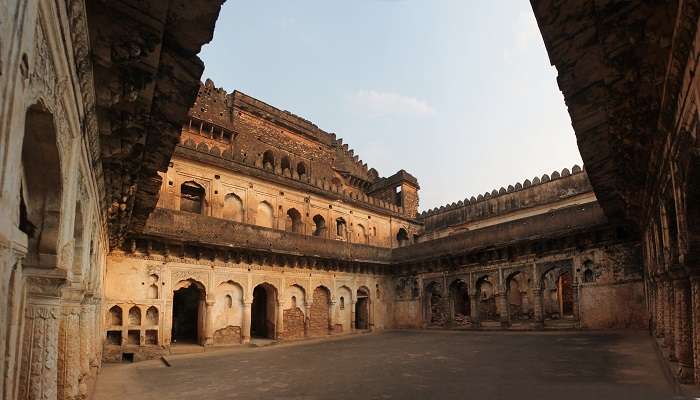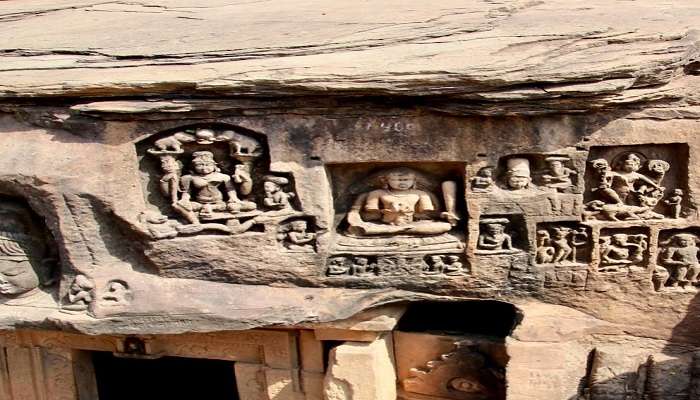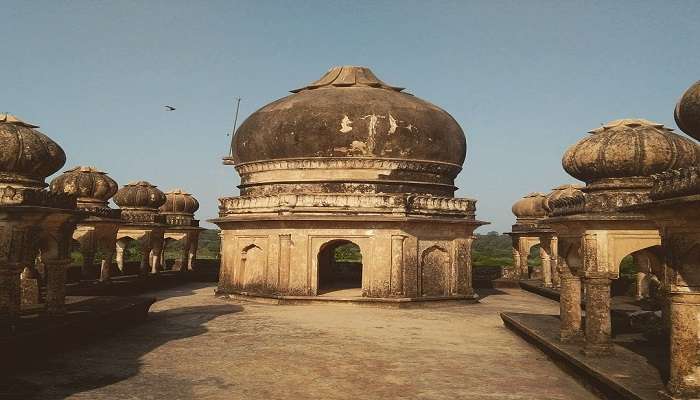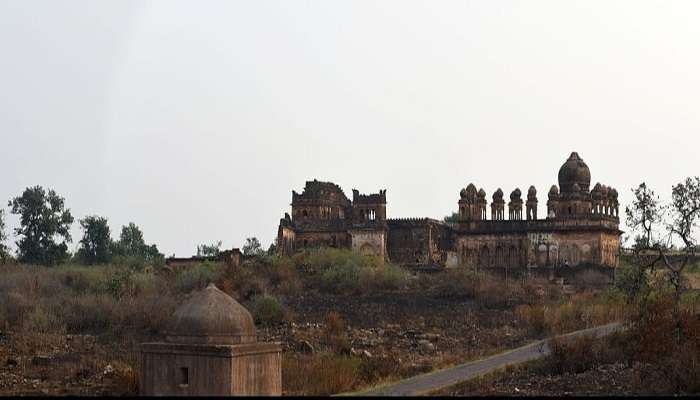A Complete Guide To Kalinjar Fort For A Perfect Trip In 2026

Kalinjar Fort is a historic fortress located at Kalinjar in Banda District, Uttar Pradesh. It’s one of the eight famous forts built by the Chandela kings. It sits on an isolated hilltop, part of the Vindhya Range, standing 244 meters above the surrounding plain. The fort’s main body is shaped like an elongated oval, spanning roughly 1.6 kilometres from east to west and 0.8 kilometres from north to south. The height of the walls varies from 30 to 35 meters and is about 8 meters thick. The fortress was constructed using large sandstone and granite blocks. The name Kalinjar is derived from the belief that Lord Shiva once rested here, where he destroyed the time barrier (kala). Even today, people believe that Lord Shiva continues to reside here.
The fort has two entrances, one on the north side facing the town and the other at the southeastern angle leading towards Panna, Madhya Pradesh.
History And Architecture Of Kalinjar Fort

Kalinjar Fort is one of the oldest and most iconic forts founded many centuries ago. According to local traditions, the fort has been named ‘Kalinjar’ where the word ‘Kalanjar’ has been taken from Sanskrit meaning ‘Destroyer of time’; this is because this place is believed to be the place where Lord Shiv defeated the god of time called Yama. The historical records indicate that the Fort of Kalinjar has been a pivotal strategic and war side for centuries. Serving as a major regime for different dynasties, it has seen the golden age of rulers, including the Chandela rulers, who were very famous for their love towards art and structure. In anticipation of Mahmud of Ghazni’s lashes, Kalinjar was further developed and strengthened in the 11th century by the Chandela king Vidyadhara. It has heavily fortified walls made of stone and beautifully carved doorways that contributed to the repulsed of several attacks.
The Kalinjar Fort, too, has its historical importance during the medieval age. Later in the 16th century, it was brought under the Mughal Empire for administration. In 1545, the fort changed hands from the Mughal emperor Humayun to the Afghan ruler Sher Shah Suri who died during the siege. Later on, the fort was again at the centre of the conflicts between the Mughals and other chiefs. During the 18th century, Kalinjar Fort was taken over by Marathas who further ruled until the British time. The fort was later handed over to the British East India Company in the early nineteenth century and it was under the British colonial authority until the independence of India in 1947. The architecture of the Kalinjar Fort is a unique mixture of different architectures based on different dynasties that ruled the place for centuries. The fort contains several temples, palaces, and tanks, and it has beautiful sculptures and inscriptions depicting the artistry of Chandelas and other dynasties.
Must Read: Places To Visit Near Khajuraho
What To See In Kalinjar Fort

The Fort was located on a high hillock in the Vindhyan ranges, one has to cross seven gates or check posts to enter into the main area of the Fort. These magnificent gateways are the Alam Darwaza, or Almgir Darwaza, Ganesh Dwar, Chandi or Chauburji Darwaza, Budha Bhadra Drwaza, Hanuman Dwar, Lal Darwaza and Bara Darwaza. The complex of the fort still bears two remnants of the palace, the Raja Mahal and the Rani Mahal.
Other interesting spots within the main fort area include Sita Sej, a small cave containing a stone bed and pillow for the use of hermits, Patal Ganga, the reservoir cut in rocks; Pandu Kund, where water trickles from the horizontal rock strata crevices, Bhairon ki Jharia with the gigantic figure of Bhairon carved on the rock – mostly called as Manduk Bhairav and lastly Koti Tirth and the Budha Budhai Taal, which is believed to have curative qualities for ailments, are the key attraction of pilgrims at Kalinjar. Other important attractions are the Nilkanth temple constructed by Parmardideva of Chandela dynasty, where is the rock-cut Swarga Rohan Kund and in it, a colossal figure of Kal-Bhairav, with eighteen arms, two and a half feet broad and twenty-four feet high, ornamented with a garland of skulls.
How To Reach Khalinjar And Accommodation Nearby

Local transport facilities include taxis and buses from the neighbouring towns and cities, including Banda and Khajuraho.
By Air: The nearest airport is located at Khajuraho, about 130 kilometres from the spot.
By Train: The nearest railway station is Atarra, 36 km away. It is on the Banda-Satna rail route, 57 km away from Banda rail station.
By road: The Kalinjar Fort is well connected by Road to all the important centres in the region, with bus services available. Some of the major road distances are Chitrakoot, 78 km away; Banda, 62 km away; Khajuraho, 130 km away; and Allahabad, 205 km away.
Khajuraho is the nearest town, located at a distance of around 75 kilometers from Kalinjar. Many options for accommodation are good and comfortable to stay in, they include the Lalit Temple View Khajuraho, Radisson Jass Hotel Khajuraho, and Syna Heritage hotel.
Suggested Read: Things To Do In Khajuraho
Best Time To Visit

The best season to visit Kalinjar Fort is from October to March as it is mostly clear weather. Here’s a breakdown of the seasonal conditions:
- October to March: These months are preferred for travelling as the climate is moderate – between 10°c and 25°c. Another advantage of the climatic condition is that the temperature of the environment is relatively low, thus making it enjoyable when touring the fort.
- April to June: These months may be referred to as hot summer since the hot temperature may reach its peak of 45 degrees Celsius. This climate is quite unfavourable for walking tours and sightseeing as the heat can be physically unbearable and is typically avoided by tourists.
- July to September: The amount of annual precipitation varies depending on the monsoon with moderate to heavy rain experienced during this period. However, one must also remember that the fort and its surroundings are quite green and wet at this time of the year, and though the rain typically is not very heavy, it can be annoying when it comes to visiting open territory and climbing steep paths. Further, the approach to this fort may be hazardous due to bad road conditions of the place and the terrains that may be slippery at times.
Further Read: Hill Stations Near Uttar Pradesh
After all the information to explore the historical Kalinjar fort, plan your trip to Khajuraho, the town nearby. Khajuraho is renowned for its temples, which are historically included in the list of UNESCO. Khajuraho provides tourists with an idea of the artistic and apogee of medieval India.
For our editorial codes of conduct and copyright disclaimer, please click here.
Cover Image Credit: Sagar Das for Wikimedia Commons
Frequently Asked Questions About Khalinjar Fort
How many hours would you recommend for a tour of Kalinjar Fort?
One should determine to take 3-4 hours to effectively tour the Fort and incorporate all the attractions it has to offer. Suppose you are a person who is looking for more detail or photographs. In that case, you may wish to spend more time.
What clothes and gear are appropriate for visiting Kalinjar Fort?
Bring along comfortable and weather-appropriate clothing plus sneakers or sturdy shoes because several areas of the fort require walking on rugged terrains and climbing a few stairs. Carry sunscreen, hats, sunglasses, and similar items should be carried when going out in the sun.
Does Kalinjar Fort have a fixed amount that one needs to pay to be allowed to tour the compound?
The latest information about the Kalinjar Fort does not point to any official charges levied for entry to the site. Nonetheless, it is recommended that one consult the local police headquarters or tourism bureaus for this information.
What are those considerations you should have when you are planning to visit Kalinjar Fort?
Regarding the safety concerns, it is safe to visit and tour Kalinjar Fort but visitors should remain especially careful while moving around the fort structure where there are steps as well as other kinds of terrains. Proper footwear should be worn and water should also be carried along the journey, and it is also pertinent to cross the restricted part of the fort.
Where can one eat around the area of Kalinjar Fort?
The few available food joints and restaurants can be sourced from the neighbouring towns of Banda and Mahoba, which provide traditional Indian cuisine, particularly from the northern region.
People Also Read:
Red Fort Orchha Fort Mehrangarh Fort

With a passion for exploring and travelling to the roads long forgotten, experience the world through enthralling stories and adventures. Join me as I share my experiences at some of the world’s most popular tourist destinations and quench that pestering curiosity with something exciting!











